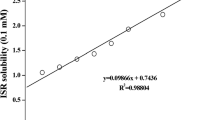Abstract
The present investigation was undertaken with the objective of formulating TC containing fast dissolving films for local delivery to oral cavity. Various film forming agents, film modifiers and polyhydric alcohols were evaluated for optimizing the composition of fast dissolving films. The potential of poloxamer 407 and hydroxypropyl-β- cyclodextrin (HPBCD) to improve solubility of TC was investigated. Fast dissolving films containing hydroxypropyl methylcellulose (HPMC), xanthan gum, and xylitol were formulated. Use of poloxamer 407 and HPBCD resulted in significant improvement in the solubility of TC. Fast dissolving films containing TC-HPBCD complex and TC-Poloxamer 407 were formulated and were evaluated for the in vitro dissolution profile and in vitro microbiological assay. Films containing TC-Poloxamer 407 exhibited better in vitro dissolution profile and in vitro antimicrobial activity as compared to the films containing TC-HPBCD complex. Effect of incorporation of eugenol on the in vivo performance of TC-Poloxamer 407 containing films was evaluated in human volunteers. Eugenol containing films improved the acceptability of TC-Poloxamer 407 films with respect to taste masking and mouth freshening without compromising the in vivo dissolution time.



Similar content being viewed by others
References
H. P. Nissen, and D. Ochs. Triclosan an antimicrobial active ingredient with anti-inflammatory activity. Cosm. Toilet. 113:61–64 (1998).
N. Surolia, and A. Surolia. Triclosan offers protection against blood stages of Malaria by inhibiting enoyl ACP reductase of Plasmodium falciparum. Nat. Med. 7:167–173 (2001).
J. Regos, and H. R. Hitz. Antimicrobial spectrum of triclosan: a broad spectrum antimicrobial agent. Zbl. Bakt. Hyg. A Orig. A. 226:390–401 (1974).
R. J. Jackson. Metal salts, essential oils and phenols- old or new. Periodontol. 15:63–73 (1997).
A. Scheie. Modes of action of currently known chemical anti plaque agents other than chlorhexidine. J. Dent. Res. 68:1609–1616 (1989).
D. J. Bradshaw, P. D. Marsh, G. K. Watson, and D. Cummins. Effects of triclosan and zinc citrate, alone and in combination, on a community of oral bacteria grown in vitro. J. Dent. Res. 72:25–30 (1993).
Y. J. Lin. Buccal absorption of triclosan following topical mouthrinse application. Am. J. Dent. 13:215–217 (2000).
S. B. Borsadia, D. O’Halloran, and J. L. Osborne. Quick-dissolving films—a novel approach to drug delivery. Drug Delivery Technology. 2(2) (2003). Available at http://www.drugdeliverytech.com/cgi-bin/articles.cgi?idArticle. Accessed July 3, 2003.
A. C. Liang, and L. Chen. Fast dissolving intraoral drug delivery systems. Expert Opin. Ther. Pat. 11:981–986 (2001).
T. Loftsson, N. Leeves, B. Bjonsdottir, L. Duffy, and M. Masson. Effect of cyclodextrins and polymers on triclosan availability and substantivity in toothpastes in vivo. J. Pharm. Sci. 88:1254–1258 (1999).
M. S. Nagarsenker, and G. Ramprakash. Influence of preparation methodology on solid-state properties of an acidic drug-cyclodextrin system. J. Pharm. Pharmacol. 56:725–733 (2004).
S. Hamada, and H. D. Slade. Immunology and Cariogenicity of Streptococcus mutans. Microbiol. Rev. 44:331–384 (1980).
A. G. Jagtap, and S. G. Karkera. Extract of Juglandaceae regia inhibits growth, in-vitro adherence, acid production and aggregation of Streptococcus mutans. J. Pharm. Pharmacol. 52:235–242 (2000).
J. E. Polli, G. S. Rekhi, L. L. Augsburger, and V. P. Shah. Methods to compare dissolution profiles and a rationale for wide dissolution specifications for metoprolol tartrate tablets. J. Pharm. Sci. 86:690–700 (1997).
K. K. Peh, and C. F. Wong. Polymeric films as vehicle for buccal delivery: swelling, mechanical, and bioadhesive properties. J. Pharm. Pharmcol. Sci. 2:53–61 (1999).
D. M. Brahmankar, and S. B. Jaiswal. Biopharmaceutics and Pharmacokinetics: A Treatise. Vallabh Prakashan, New Delhi, India, 2003, pp. 178–203.
C. Grove, D. J. Liebenberg, W. Yang, and M. M. de Villiers. Improving the aqueous solubility of triclosan by solubilization, complex formation and in situ salt formation. J. Cosmet. Sci. 54:537–550 (2003).
R. G. Strickley. Solubilizing excipients in oral and injectable formulations. Pharm. Res. 21:201–229 (2004).
T. Coenye, K. Honraet, P. Rigole, P. M. Jimenez, and H. J. Nelis. In vitro inhibition of streptococcus mutans biofilm formation on hydroxyapatite by subinhibitory concentrations of anthraquinones. Antimicro. Agents Chemother. 51:1541–1544 (2007).
J. M. Goodson. Pharmacokinetic principles controlling of oral therapy. J. Dent. Res. 68:1625–1632 (1989).
Acknowledgements
The authors wish to acknowledge (1) Miss Harsha Uskaikar, Lecturer and Dr. Rane, Professor of the Department of Chemistry, Goa University for XRD analysis, (2) The National Facility for High Field NMR at Tata Institute of Fundamental Research, Mumbai for performing NMR studies, (3) Johnson and Johnson Ltd., for gift sample of triclosan, (4) Colgate Palmolive India for S. mutans culture sample (5) Colocon-Asia Ltd and BASF India for providing gift sample of the various excipients and (6) Mr. Abhijit Date for helping in the preparation and revision of the manuscript.
Author information
Authors and Affiliations
Corresponding author
Rights and permissions
About this article
Cite this article
Dinge, A., Nagarsenker, M. Formulation and Evaluation of Fast Dissolving Films for Delivery of Triclosan to the Oral Cavity. AAPS PharmSciTech 9, 349–356 (2008). https://doi.org/10.1208/s12249-008-9047-7
Received:
Accepted:
Published:
Issue Date:
DOI: https://doi.org/10.1208/s12249-008-9047-7




